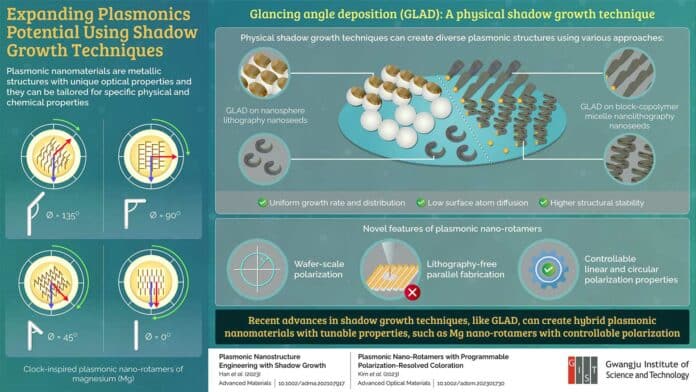Plasmonic molecules are discreet fundamental building blocks comprising multiple metallic nano-motifs arranged in a specific geometric form, giving rise to intriguing light-matter interactions akin to those observed in molecular systems. The ability to design plasmonic molecules at the nanoscale holds immense potential for polarization-sensitive optical metamaterials that are currently beyond reach.
Plasmonics involves unique interactions between light and matter on the nanoscale. Researchers from the Gwangju Institute of Science and Technology in Korea have advanced shadow growth techniques for plasmonic materials. These techniques have the potential to create nanoparticles with diverse shapes and properties.
The team has also introduced a method for large-scale production of nano-rotamers of magnesium with programmable polarization behavior. This opens up new possibilities for research applications.
In this study, researchers have provided a comprehensive overview of recent advancements in shadow growth techniques for hybrid plasmonic nanomaterials. The focus includes designs inspired by clocks containing magnesium (Mg). The term “shadow effect” in this context refers to the presence of “dark” areas on a surface concealed by “seed” molecules, making these areas inaccessible for the deposition of vaporized materials. This phenomenon is akin to shadowed areas where light cannot reach.
Doeun Kim, a Ph.D. Student says, “Since these shadowed areas are the regions where the material cannot be deposited, an array of three-dimensional nanostructures can be formed. This formation depends on the size of the seed, spacing between the seeds, and the inclination of the substrate.”
“Creation of unique nanostructures is influenced by the introduction of rotation during the process, based on rotation speed, time, and angle, ultimately forming three-dimensional nanostructures.”
In the first study, the research team demonstrated the production of various nanostructures using a specific shadow growth technique called glancing angle deposition. These structures exhibit tunable optical properties achieved through suitable material, shape, and surrounding environment modifications.
The review emphasizes a broad range of potential applications, including nano- and micro-robots for wound healing and drug delivery in the human body, photonic devices, and chiral spectroscopy, among others.
In the subsequent study, the team created 3D rotamers, molecules with specific rotational arrangements capable of both linear and circular polarization and storing significant information. This clock-inspired design involves placing two nanorods made of Mg at a certain modifiable angle, resembling a clock’s hour and minute hands.
These nanostructures hold promise for various applications, such as secure verification of items like banknotes, anti-counterfeiting devices, and displays capable of transitioning to desired optical states as needed.
These rotamers can have potential utilization in physically unclonable functions, an area currently under intensive research for ensuring robust security levels of hardware, such as PCs or servers. In particular, the ability to selectively filter UV light sources and specific visible wavelengths depending on the polarization state can also be used in glasses and windows to protect eyes and skin by blocking UV rays from sunlight.
Journal Reference:
- Juhwan Kim, Jang‐Hwan Han, Hyun Min Kim, Tung‐Chun Lee, Hyeon‐Ho Jeong. Plasmonic Nano‐Rotamers with Programmable Polarization‐Resolved Coloration. Advanced Optical Materials, 2023; 12 (2) DOI: 10.1002/adom.202301730
- Jang-Hwan Han, Doeun Kim, Juhwan Kim, Gyurin Kim, Peer Fischer, Hyeon-Ho Jeong. Plasmonic Nanostructure Engineering with Shadow Growth. Advanced Materials. DOI: 10.1002/adma.202107917
